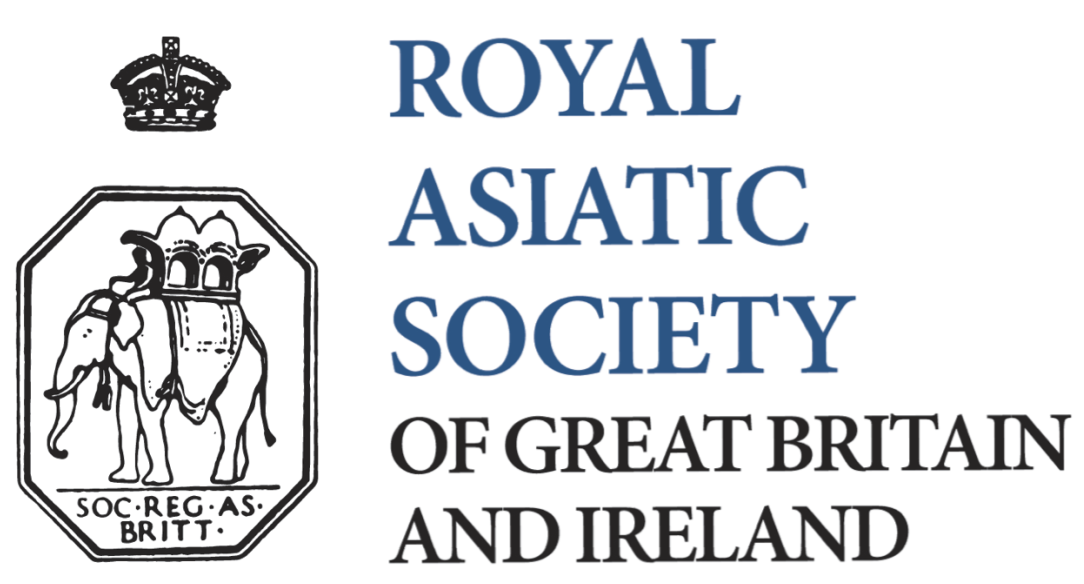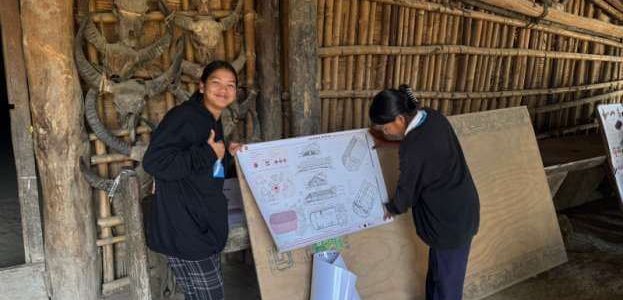Traditional Architecture in Arunachal Pradesh
We were delighted to recently receive news from the Adivasi Arts Trust, based in London, which has recently completed a project to survey traditional architecture in some of the Wancho villages in Arunachal Pradesh, northeast India. The results are collated in the Endangered Wooden Architecture Programme (EWAP) archive.
Tara Douglas of the Trust writes:
“The Wancho are a tribal community with a population of 56,866 (Census 2011), living in Longding District, in the Patkai range of eastern Arunachal Pradesh in India. The landscape is considered remote even within the Northeast region, and limited contact with outsiders, apart from neighbouring tribal groups, has helped to preserve the indigenous cultural heritage and the traditional design of local dwellings and community structures.
“The Wancho villages (Nok) are dense settlements that were typically isolated from one another. Four villages were selected for this study of architecture: Kamhua Noknu, Kamhua Noksa, Khasa and Jagan. The traditional buildings in the villages are made of local materials: wood, bamboo and palm leaf thatch. The use of organic materials and the impact of heavy annual rainfall accounts for the ephemeral nature of buildings that must be reconstructed every 8-10 years. Each rebuilding represents a significant event that brings the community together to revitalise age old practices of knowledge transmission, reciprocity and social bonding as they work cooperatively and quickly to erect a new house. The survey was done in collaboration with some of the village people, and the project was to return to the local the community in the last phase of the research. I travelled to Longding District in November 2024 to organise the workshops that were designed to share the outputs and prompt discussions with any Wancho people who would attend. It has now become more difficult to visit the district: previously, inner line permits to enter the district were issued for 30 days, but this has been reduced to 14 days. It is still possible to apply for an extension, though the procedure is complicated. The journey is over 2400 km from Delhi to Longding, and this time I had a huge amount of luggage on the train that would travel via Guwahati, in Assam. In a location where only the most general equipment and materials are available, I needed to bring whatever I could for the workshops. I packed a heavy amplifier and projector; print and promotional materials: banners, books, booklets, laminated photographs and two rolls of large sized laminated sheets for display of the architectural drawings of the 12 buildings that were surveyed. At last I travelled on from Itanagar to Longding, and then to Kamhua Noknu village with Jatwang Wangsa, who is the local collaborator for the project.
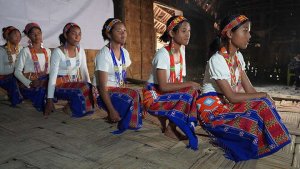
“I knew that days would slip by easily. I had brought along my urban expectations, and I was becoming impatient at the slow pace of getting anything done in the village, where I was based at the Wancho Centre for Art Culture and Knowledge. The Centre is a small initiative that had come about in 2020, when Jatwang and his family built a charming bamboo hut for me, knowing that I would love it, and that I would want to keep coming back to the village. It is another reality there: local people are intensely busy with the daily schedules of subsistence farming and community engagements, and it would be difficult to communicate my plans, even with Jatwang’s assistance as translator. An entire day would be required for him to drive a patient to the nearest hospital in Dibrugarh; and as a teacher employed by the government, he would be suddenly called away from the village to attend some workshop or other – another day’s journey. Feeling helpless, I got into the shared pick-up vehicle that leaves from the village for Longding, 35 km away early each morning: I wanted to confirm the booking of the Conference Hall at the Government Circuit House in the town for our workshop. However, no confirmation would be issued until the day before the event, just in case an unexpected official suddenly required the facility. There was no reasonable alternative available.
“Our project competes with the events that are organised by government departments and apex bodies, so how would we drum up attendance? Fortunately, I had the support of the Kamhua Noknu Student Union to organise the workshop. The protocol for a formal event is to invite a Chief Guest and a Guest of Honour: senior officials from government departments that were inevitably far away on important business in the state capital, Itanagar. At last, our confirmed Chief Guest in Longding was to be Mr. Somnai Wangpan (the President of the Wancho Society), and Dr. Manlong Ralongham (District Adult Education Officer, Longding District) as the Guest of Honour. I had also invited Dr Meera Dass from Bhopal: her expertise of architecture had drawn her into the project as an advisor; and Dr K.K. Chakravarty, an art historian, writer, academician and retired officer of the Indian Administrative Service (IAS) who would travel from Kolkata. During his career, Dr Chakravarty had headed several important cultural institutions in India, and he had been an advisor to the Adivasi Arts Trust since the beginning. Once settled at the only accommodation facility that could be provided, they both contributed insightful observations about vernacular architecture and traditional knowledge at the concluding programme.
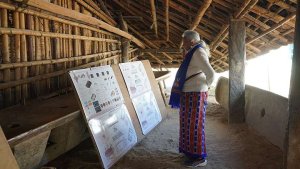
“Each village is ruled by the authority of a powerful chief who is referred to as Wangham (or Raja), and the second workshop on 6 December that took place at the Wangkam (Chief’s house) in Kamhua Noknu, was for the village community. This was the first time that our two senior guests had travelled to the site of field research. The Wangkam was one of the buildings that had been surveyed, and I was witness to its reconstruction in 2021. It had been an impressive, large community event that assembled most of the people from Kamhua Noknu, as well as those from the neighbouring villages who were expected to contribute building materials, food for the feast and labour.
“Few residents of the village speak English. As most of the elder custodians of knowledge are exclusively speakers of Wancho, communication was mediated by our colleagues from Wancho Literary Mission translating the presentations by the visitors into the local Wancho dialect. The project focuses on the essential link between architecture and culture, and the workshop was celebrated in a cultural performance by students and with gifts of handicrafts for the visitors. Village leaders commended the professional work that had been undertaken to record the architectural features and dimensions and the construction techniques. In the discussions they agreed that at least the communal buildings should be maintained in the traditional style, for as Jatwang Wangsa explained:
‘People living in the village have deep connections among themselves they come to help when it is needed. Especially Paa and chief’s house should remain traditional, otherwise we will lose songs and dance which are part of the construction event. We get the chance to assemble whenever it is rebuilt.’
“During regular visits to the area I was witnessing the accelerated pace of change and its impact on the traditional way of life. The village settlements are transforming as contemporary house owners show preference for new adaptations. The modern adaptation of the traditional house, with its frame elevated on large stones, has become popular among many families due to its durability compared to the original design, where columns and posts are set directly into the soil. However, younger generations are interested in further modifying the house structure, with some envisioning future homes constructed from concrete. The number of structures of concrete and galvanized iron sheets in the villages is steadily increasing. In Kamhua Noknu there are half a dozen such constructions, and in 10 years it is realistic to expect a broadly modified village character and vista. It is hoped that the archive will promote interest and value of the indigenous architecture that might inspire local people to sustain the cultural heritage.
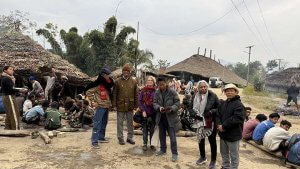
“It was the season for house construction, and walking through the village that day, Hondan Losu’s traditional house, which had been surveyed for the project, was now being reconstructed. The building of a house is a noisy, amicable activity that brings the community together, and hard work is rewarded by a feast that is provided to everyone by the house owner. Awareness of the tradition for all community events in village to include a feast, the documentation team invited the elder people of the village for a community lunch in the Wangkam to celebrate the project. As recounted by Gukhang Ngopa, the team is always directed by leaders acting as the managers to arrange for the different food ingredients at the feast: there are meat managers (Maiding-pa), wine and vegetable managers (Shoi-pa) and rice managers (Thamkan-pa). House construction also requires the presence of the Pastor who offers prayers prior to the feast, and at the end there is no sign of either wasted food or disposable plastic waste.”
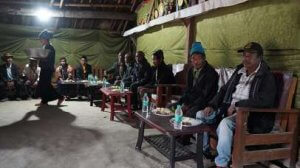
Wangkam, Kamhua Noknu
You can view the video ‘Documentation of Traditional Architecture in the Wancho Villages of Arunachal Pradesh’ here, delivered by Dr Meera Dass at the workshop in Longding in December 2024 to celebrate the completion of the research project. Tara also provide links to other short films. These are: Wancho Nyoi (a small room for elder people), The Wancho Hailay (Bamboo platform), Building a Frame House with Khaupa Wangham, Pasa (a small house for teenagers), and Kamdong Ritual.
More information about the Adivasi Arts Trust and the project can be found on their website.
~ ~ ~ ~ ~
It is with sadness that we pass on the news from Reverend Steven L. Shields, the President of the Royal Asiatic Society Korea, that their vice president, Suzanne Crowder Han died on Monday 10 February after a short illness. Suzanne was a lifelong member of RAS Korea and contributed much to the Society through many years of service on the Council and in leadership positions. This past year, as vice president, Suzanne took the reins of leading the Society when their president needed to step back for his own health reasons.
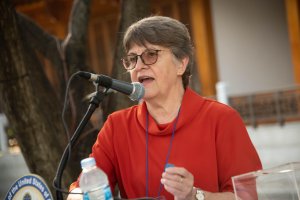
Suzanne first arrived in Korea in the mid-1970s with the Peace Corps to teach English, and she continued there in a career of teaching and writing. She retired from full-time work as an educator just last year. Her series of children’s books featuring “The Rabbit” was much loved by children worldwide, and her pictorial guidebooks of Seoul, Gyeongju, and Jeju Island were instrumental in boosting tourism to those places. Her book, “Notes on Things Korean,” was a masterpiece of reflections on the culture from a Westerner’s point of view and was helpful and respectful.
We send our condolences to all those who knew her.
Nancy Charley, 21 February 2025. Photographs of the Adivasi Arts Trust Project courtesy of Tara Douglas.
